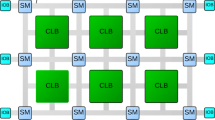Abstract
I DDQ measurement is a time consuming process. Thus, reducing the number of I DDQ measurements have a great impact on the test time. Carefully selecting a few I DDQ measurement points is therefore an important problem. This problem has been studied for detecting leakage faults but not for bridging faults. We present novel algorithms to select I DDQ measurement points to detect bridging faults. Experimental results obtained are very encouraging. The method can also be used: by test generators to compress I DDQ test sets; and to maximize the fault coverage when a fixed number of measurement points are given.
Similar content being viewed by others
References
W. Maly, J.P. Shen, and F.J. Ferguson, “Systematic Characterization of Physical Defects for Fault Analysis of MOS IC Cells,” Proc. IEEE Int'l Test Conference, Sept. 1984, pp. 390–399.
D. Feltman et al., “Current Sensing for Built-in Testing of CMOS Circuits,” Proc. 1988 Int'l Conf. on Computer-Aided Design, pp. 454–457.
W. Maly and P. Nigh, “Built-in Current Testing: Feasibility Study,” Proc. 1988 Int'l Conf. on Computer-Aided Design, pp. 340–343.
P. Nigh and W. Maly, “Test Generation for Current Testing,” IEEE Design and Test of Computers, Vol. 7, pp. 26–38, Feb. 1990.
W. Mao, R.K. Gulati, D.K. Goel, and M.D. Ciletti, “QUIETEST: A Quiescent Current Testing Methodology for Detecting Leakage Faults,” in Proc. 1990 IEEE Int'l Conf. on Computer-Aided Design, pp. 280–283.
S. Chakravarty and P.J. Thadikaran, “A Study of I DDQ Subset Selection Algorithm for Bridging Faults,” Proc. IEEE International Test Conference, 1994, pp. 403–412.
U. Mahlstedt, J. Alt, and M. Heinitz, “CURRENT: A Test Generation System for I DDQ Testing,” Proc. IEEE VLSI Test Symposium, 1995, pp. 317–323.
D.S. Johnson, “Approximation Algorithms for Combinatorial Problems,” J. Comb. and Sys. Sci., 1974, Vol. 9. pp. 256–278.
S. Chakravarty and A. Shekhawat, “Parallel and Serial Heuristics for the Minimum Set Cover Problem,” Journal of Supercomputing, No. 5, pp. 331–345, 1992.
K.J. Lee and M.A. Breuer, “Design and Test Rules for CMOS Circuits to Facilitate I DDQ Test of Bridging Faults,” IEEE Trans. on Comput.-Aided Design, Vol. 5, pp. 659–669, May 1992.
S. Chakravarty and M. Liu, “Algorithms for Current Monitor Based Diagnosis of Bridging and Leakage Faults,” Proc. 29th ACM/IEEE Design Automation Conference, 1992, pp. 353–356.
S. Chakravarty and M. Liu, “Algorithms for Current Monitor Based Diagnosis of Bridging and Leakage Faults,” Journal of Electronic Testing: Theory and Applications, Vol. 3, pp. 377–385, 1992.
S. Chakravarty and S. Suresh, “I DDQ Measurement Based Diagnosis of Bridging Faults in Full Scan Circuits,” in Proc. IEEE Int'l Symposium of VLSI DESIGN'94, pp. 179–182.
S. Chakravarty and P.J. Thadikaran, “Simulation and Generation of I DDQ Tests for Bridging Faults in Combinational Circuits,” Proc. 1993 IEEE VLSI Test Symposium, pp. 25–32.
S. Chakravarty and P.J. Thadikaran, “Simulation and Generation of I ddq Tests for Bridging Faults in Combinational Circuits,” IEEE Trans. on Comput. (to appear).
W. Debany, “Coverage of Node Shorts Using Internal Access and Equivalence Classes,” Proc. VLSI Design, 1993, Vol. 1,No. 1, pp. 71–86.
R. Rodriquez-Montanes and J. Figueras, “Analysis of Bridging Defects in Sequential CMOS Circuits and their Current Testability,” Proc. European Desing and Test Conference, March 1994.
F. Brglez and H. Fujiwara, “A Neutral Netlist of 10 Combinational Benchmark Circuits and a Target Translator in Fortran,” special session on ATPG and Fault simulation, Proc. IEEE Int'l. Symposium on Circuits and Systems, 1985.
F. Brglez, D. Bryant, and K. Kozminski, “Combinational Profiles of Sequential Bench-Mark Circuits,” Proceedings of Proc. IEEE Int'l Symposiumon Circuits and Systems, 1989, pp. 1929–1934.
T. Larabee, “Test Pattern Generation Using Boolean Satisfiability,” IEEE Trans. on Comput.-Aided Design, Vol. 11, No. 1, pp. 4–15, Jan. 1992.
H.K. Lee and D.S. Ha, “HOPE: A Fast Parallel Fault Simulator for Sequential Circuits,” Proc. of Design Automation Conference, June 1992.
W.T. Cheng and T.J. Chakraborty, “GENTEST: An Automatic Test Generation System for Sequential Circuits,” Computer, Vol. 22, April 1989.
Author information
Authors and Affiliations
Additional information
Research supported by NSF Grant No. MIP-9102509.
Rights and permissions
About this article
Cite this article
Chakravarty, S., Thadikaran, P.J. Algorithms to select I DDQ measurement points to detect bridging faults. J Electron Test 8, 275–285 (1996). https://doi.org/10.1007/BF00133389
Received:
Revised:
Issue Date:
DOI: https://doi.org/10.1007/BF00133389




